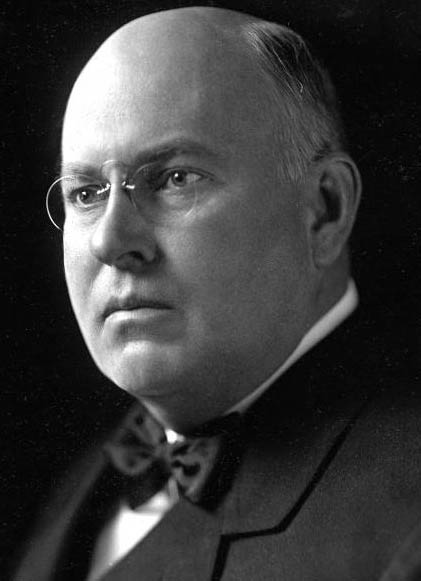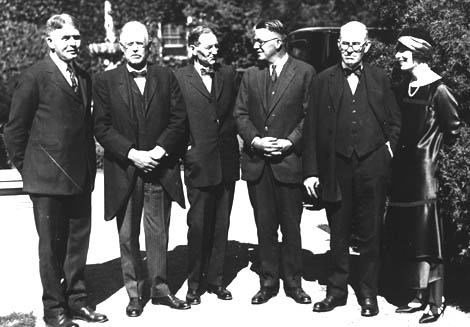

THE NEWMONT GOLD COMPANY
|
The Newmont Gold Company is based in Green Wood Village Nevada, in the United States of America, it is the world's largest gold mining company. Incorporated in 1921, it has Ownership of Gold mines in Nevada, Colorado, Ontario and Quebec. |

|
William Boyce Thompson May 18, 1869 ~ June 27, 1930 William Boyce Thompson was an American mining engineer, financier, prominent in the Republican party, philanthropist, and founder of Newmont Mining. Thompson was one of the significant early twentieth century mine operators that discovered and exploited vast copper deposits that revolutionized Western American mining, and reaped for themselves tremendous fortunes. He currently has a school named after him in Yonkers, New York, called the William Boyce Thompson school. Born in Virginia City, Montana, and raised in Butte, he was schooled in the rough mining towns of southwest Montana, but also at Phillips Exeter Academy and the Columbia School of Mines. During the 1890s he joined his father, William, one-time mayor of Butte, in Montana mining and lumber ventures, before moving east to become a mine promoter and stockbroker. His first success, the Shannon Copper Company, where he opened mines, built a smelter, and a railroad between them, is now part of the vast Morenci, Arizona, open pit, largest in the United States. Joining the brokerage firm of Hayden, Stone & Co. during the early 1900s he expanded his promotions: to Elko, Nevada, where he helped organize the Nevada Consolidated, which eventually became a part of the multinational Kennecott Copper Company, of which he was a director. Mason Valley where he opened old copper mines and built his smelter town which was named Thompson, Nevada after him; and most fortuitously in the 1910s opened the Magma mine at Superior, Arizona, which became a major copper producer; and the promotion of the incredibly rich Inspiration Copper Company at Inspiration, Arizona, near Miami, Arizona, during the 1910s, all made him fabulously wealthy. He had built a large fortune developing low grade, large scale porphyry copper deposits at the same time he got lucky with his high-grade Magma mine, which proved a phenomenal bonanza. He retired from the New York stock exchange in 1915 and later created his own holding company, Newmont Mining Corporation, to which he transferred his many mining interests. By the time of his death, Newmont Mining was a major factor in world copper production. Today, Newmont is the largest gold producer in the United States but continues the legacy of Thompson to explore and bring into production new ore deposits. Thompson's promotions and financial holdings were scattered from Canada to Peru. They included Indian Motorcycle Co. He financed lead, zinc and coal mines, street railways, handled the sensational Midvale Steel financing during the War when the stock rose from 290 to 500. He promoted the great Nipissing silver deposit at Cobalt, Ontario, Canada for the Guggenheims and reaped a quick million dollars return. He refinanced American Woolen Co. and Tobacco Products Co. launched Cuba Cane Sugar Co., got control of Pierce-Arrow Motor Car Co, organized Submarine Boat Corp. and the Wright-Martin Aeroplane Co. He was a director of the Metropolitan Life Insurance Company. By the 1920s he was a director of Sinclair Oil and promoter of Gulf Sulphur, but all these were diversions from his main interest in mining copper. In 1925, when planning to scout mining properties in South Africa, he became ill and returned home halfway through the trip, his last, lingering illness. Rotund, good-natured, bald, a tireless worker, a devoted family man, Thompson chewed tobacco, underpaid his employees and, as one of the greatest gamblers of his time, discharged them for gambling. He was prominent behind the scenes in the Republican party, a presidential elector, party chair, as well as served on the Federal Reserve Bank of New York from 1914 to 1919 and was twice a delegate to the Republican National Convention. In 1921, he declined nomination for a cabinet post under president Warren G. Harding. He was head of and principal supporter of the President Theodore Roosevelt Memorial Association from 1919 until his death. In 1912, he built the W. B. Thompson Mansion at Yonkers, New York. It was added to the National Register of Historic Places in 1982. During the 1920s, near Superior, Arizona, he built his winter mansion, Picket Post House, overlooking the beautiful desertscape and gardens he created at what is now the magnificent Boyce Thompson Arboretum State Park. The Mediterranean style home is occasionally open for tours through the arboretum. In 1925, Thompson ordered a luxuriant private railroad car, named the Alder, from the Pullman Company. The car was later used by ASARCO and in 1971 was owned by the National Railways of Mexico.
The mausoleum of William Boyce Thompson Thompson died from pneumonia in 1930 and was buried at the Sleepy Hollow Cemetery. A 1935 biography of Boyce-Thompson, The Magnate, by Herman Hagedorn, the presidential biographer of Theodore Roosevelt, profiles his life. |
|

|
His portrait was painted by the Swiss-born American artist Adolfo Müller-Ury about 1920-5, and was donated to the New York Chamber of Commerce around 1948/9 by the artist's friend, the soprano Jessica Dragonette who had acquired it from the artist's estate; she claimed in her autobiography 'Faith is a Song' that she offered it to Thompson's daughter who set a fee for the privilege of destroying the portrait. The portrait is now in the New York State Museum at Albany.
FaceBook | Twitter | YouTube | LinkedIn
Email the Webmaster
|